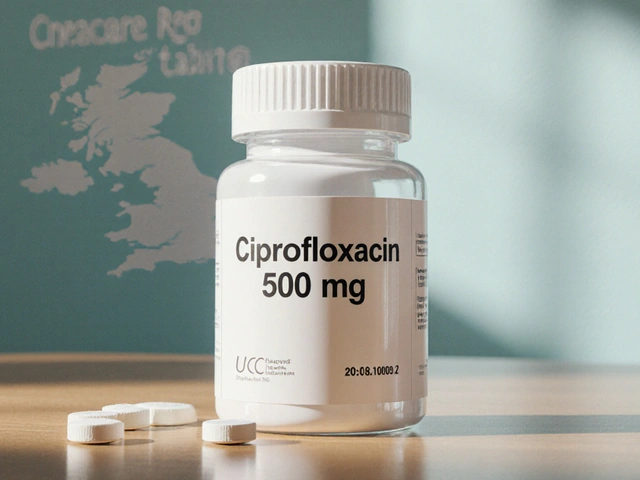Fluorouracil is a pyrimidine analog chemotherapeutic agent that interferes with DNA synthesis by inhibiting thymidylate synthase. It has been a backbone of many solid‑tumor protocols for decades, and its role in pancreatic cancer has evolved alongside newer combinations. When doctors talk about 5‑FU in pancreatic cancer, they’re usually referring to its inclusion in multi‑drug regimens or as a radiosensitiser. This article walks through the science, the real‑world evidence, and the practical choices you’ll encounter in a clinic.
Why Fluorouracil Still Matters
Even though newer agents like gemcitabine and nab‑paclitaxel dominate headlines, Fluorouracil offers three concrete advantages:
- It is inexpensive and widely available, making it a viable option in low‑resource settings.
- Its toxicity profile, while not trivial, is well‑characterized; clinicians know how to dose‑adjust for kidney or liver impairment.
- When combined with other drugs, it produces synergistic DNA damage that can improve response rates.
These points matter especially when a patient cannot tolerate the more aggressive FOLFIRINOX schedule or when insurance limits access to newer drugs.
Mechanism of Action - The Biochemical Play
Fluorouracil (5‑FU) is converted inside the cell to fluorodeoxyuridine monophosphate (FdUMP). This metabolite forms a stable ternary complex with thymidylate synthase and folate, effectively halting the synthesis of deoxy‑TMP, a building block of DNA. Without deoxy‑TMP, cancer cells cannot replicate their DNA and undergo apoptosis.
In pancreatic adenocarcinoma, the high proliferative index makes this blockade particularly lethal. Moreover, 5‑FU induces RNA mis‑incorporation, which disrupts protein synthesis, adding another layer of cytotoxicity.
Key Clinical Regimens Featuring Fluorouracil
The drug rarely runs solo; instead, it joins forces with other agents. Below are the most common setups.
FOLFIRINOX
FOLFIRINOX is a combination of fluorouracil, leucovorin, irinotecan, and oxaliplatin. Originally designed for metastatic colorectal cancer, the regimen earned a place in pancreatic therapy after a 2011 phase II trial showed median overall survival of 11.1months versus 6.8months with gemcitabine alone. The trade‑off is higher hematologic and gastrointestinal toxicity, so patient selection is crucial.
Gemcitabine + 5‑FU (Gemcitabine‑Based Doublets)
Adding low‑dose 5‑FU to gemcitabine can increase response without dramatically raising adverse events. A Japanese phase III study reported a 3‑month improvement in progression‑free survival, especially in patients with borderline resectable disease.
Capecitabine (Oral Fluorouracil Prodrug)
Capecitabine is an oral fluoropyrimidine that converts to 5‑FU in tumor tissue. It offers convenience for patients who struggle with frequent IV access. In the ESPAC‑4 trial, capecitabine combined with gemcitabine extended median survival to 28months versus 25months with gemcitabine alone-statistically significant but modest.
Dosing and Administration Details
Fluorouracil can be given as a bolus, continuous infusion, or oral prodrug. The choice influences both efficacy and side‑effects.
- Bolus 5‑FU: 400mg/m² over 5minutes, typically on days 1 and 2 of a 14‑day cycle. Provides rapid plasma peaks but higher rates of mucositis and neutropenia.
- Continuous infusion: 2400-3000mg/m² over 46hours. Reduces peak‑related toxicities, improves tumor exposure, and is the preferred method in FOLFIRINOX.
- Oral capecitabine: 1250mg/m² twice daily for 14 days followed by a 7‑day break. Requires careful renal dosing.
Leucovorin is often co‑administered to stabilize the FdUMP‑thymidylate synthase complex, boosting 5‑FU’s anti‑cancer effect.
Side‑Effects and Management Strategies
Every chemotherapy comes with a price. For Fluorouracil, the most common toxicities include:
- Myelosuppression: neutropenia and thrombocytopenia; monitor CBC weekly, use G‑CSF prophylaxis in high‑risk cycles.
- Gastrointestinal: nausea, vomiting, diarrhea; anti‑emetics (5‑HT3 antagonists) and loperamide as needed.
- Hand‑foot syndrome: more frequent with capecitabine; dose‑reduce or pause treatment at grade2.
- Cardiotoxicity: rare chest pain or arrhythmia, especially with rapid bolus; prefer continuous infusion in susceptible patients.
Pre‑emptive counseling and dose adjustments based on renal or hepatic function keep most patients on schedule.

Comparative Efficacy - How Does Fluorouracil Stack Up?
| Regimen | Mechanism | Typical Dose (per cycle) | Median Overall Survival (months) | Grade3/4 Toxicity Rate |
|---|---|---|---|---|
| FOLFIRINOX | DNA synthesis inhibition + topoisomeraseI blockade + platinum‑DNA adducts | 5‑FU 2400mg/m² 46h infusion + irinotecan 180mg/m² + oxaliplatin 85mg/m² | 11.1 | ~65% |
| Gemcitabine + 5‑FU | Pyrimidine analog + nucleoside analog | Gemcitabine 1000mg/m² weekly + 5‑FU 2400mg/m² 46h infusion | 9.5 | ~45% |
| Gemcitabine monotherapy | Nucleoside analog | 1000mg/m² weekly | 6.8 | ~30% |
The table shows that adding Fluorouracil to gemcitabine or using it in the FOLFIRINOX backbone consistently improves survival, but at the cost of higher severe toxicity. The decision hinges on performance status, comorbidities, and patient preference.
Guidelines and Patient Selection
NCCN Guidelines provide evidence‑based recommendations for pancreatic cancer, including when to use 5‑FU‑based regimens. According to the 2024 update:
- FOLFIRINOX is preferred for fit patients (ECOG0‑1) with metastatic disease.
- Gemcitabine+capecitabine or gemcitabine+5‑FU is recommended for patients with moderate frailty (ECOG2).
- Single‑agent 5‑FU is reserved for patients who cannot tolerate any platinum‑containing regimen and have exhausted gemcitabine options.
Genetic markers also guide therapy. Tumors harboring a KRAS mutation (present in >90% of pancreatic cancers) typically do not respond to EGFR‑targeted drugs, making chemotherapy the primary line.
Future Directions - Where Is Research Heading?
New trials are testing 5‑FU in combination with immunotherapy (e.g., PD‑1 inhibitors) and with novel targeted agents like PARP inhibitors for BRCA‑mutated pancreatic cancer. Early phase results suggest that Fluorouracil may prime the tumor micro‑environment, enhancing immune checkpoint efficacy.
Another hot area is metronomic dosing-low‑dose continuous 5‑FU to suppress angiogenesis while minimizing toxicity. A 2023 multicenter study reported median progression‑free survival of 8.9months in patients unsuitable for full‑dose regimens.
Putting It All Together - A Practical Checklist
- Assess performance status: ECOG0‑1 → consider FOLFIRINOX; ECOG2 → gemcitabine+5‑FU or capecitabine.
- Review comorbidities: renal impairment favors capecitabine dose reduction; cardiac disease steers away from rapid bolus 5‑FU.
- Check genetic profile: BRCA or PALB2 mutations may open doors to PARP + 5‑FU trials.
- Plan supportive care: anti‑emetics, growth‑factor support, and early nutrition intervention improve tolerability.
- Follow guideline milestones: imaging every 8‑12weeks, labs weekly during active cycles.
By aligning these steps with the patient’s goals-whether extending life, preserving quality, or preparing for surgery-oncologists can tailor Fluorouracil‑based therapy to each individual.
Key Takeaways
Fluorouracil remains a workhorse in pancreatic cancer, especially when combined in multi‑drug regimens. It offers a proven survival boost, a well‑known side‑effect profile, and cost‑effectiveness that newer agents can’t match. Understanding when and how to use it-guided by NCCN recommendations, performance status, and emerging biomarkers-ensures patients receive the most appropriate care.

Frequently Asked Questions
What is the main advantage of Fluorouracil over gemcitabine?
Fluorouracil is generally cheaper and can be combined with other agents to achieve higher response rates. While gemcitabine alone offers modest survival, adding 5‑FU (or using it in FOLFIRINOX) consistently extends median overall survival by 2‑3months in clinical trials.
Is oral capecitabine as effective as IV 5‑FU?
In pancreatic cancer, capecitabine has shown comparable efficacy to IV 5‑FU when paired with gemcitabine. The ESPAC‑4 study demonstrated a modest survival benefit, though patient adherence and renal function require close monitoring.
Who should avoid the FOLFIRINOX regimen?
Patients with poor performance status (ECOG≥2), significant cardiac disease, or uncontrolled infections are at high risk of severe toxicity from FOLFIRINOX. In those cases, gemcitabine‑based doublets or single‑agent 5‑FU are safer alternatives.
How often should labs be checked during Fluorouracil therapy?
Complete blood counts and liver function tests are typically performed weekly during active cycles. Adjustments are made if neutrophils fall below 1.0×10⁹/L or transaminases exceed three times the upper limit of normal.
Can Fluorouracil be used after disease progression on gemcitabine?
Yes. Several second‑line studies have used 5‑FU‑based regimens after gemcitabine failure, reporting disease control rates of around 30% and median survival of 5‑6months. Selection hinges on patient tolerance and prior toxicities.




Comments
21 Comments
Susan Haboustak
Let me tell you, I’ve seen so many patients on 5-FU crash hard from hand-foot syndrome-no one warns them enough. I had one lady who kept working her retail job, refused to stop, and ended up with blisters the size of quarters. You can’t just say ‘dose reduce’ like it’s a light switch. It’s not that simple.
And don’t get me started on the GI toxicity. I’ve had to hospitalize three people this year alone because they thought loperamide would ‘fix’ it. It doesn’t. Not when the mucosa is already shredded.
Also, why is everyone ignoring the cardiotoxicity? That slow infusion isn’t just for convenience-it’s a lifesaver for patients with even mild CAD. I’ve seen arrhythmias pop up from bolus doses in people who never had heart issues before. It’s scary.
And yes, it’s cheap-but cheap doesn’t mean safe. We’re trading cost for patient suffering, and nobody’s tracking the long-term quality of life. Just numbers.
Someone needs to start asking: are we extending life… or just prolonging suffering?
Chad Kennedy
ok but like… why even use 5-FU anymore? gemcitabine is easier. less side effects. less hassle. why make people suffer for a drug that’s 30 years old? it’s like using a flip phone when you have a iphone. just saying.
also who even does continuous infusions anymore? that’s so 2005. nobody wants to be hooked up to a pump for 46 hours. it’s ridiculous.
Siddharth Notani
Respected colleagues, the biochemical precision of fluorouracil’s mechanism-particularly its ternary complex formation with thymidylate synthase-remains a cornerstone of cytotoxic pharmacology. While newer agents offer convenience, the metabolic specificity of 5-FU, coupled with leucovorin potentiation, ensures a targeted disruption of DNA synthesis that is difficult to replicate.
Furthermore, in resource-constrained settings, its affordability enables equitable access. In India, where many patients pay out-of-pocket, 5-FU-based regimens remain the only viable option for systemic therapy.
Let us not discard a proven agent due to novelty bias. Evidence, not trend, must guide our practice.
With deepest respect,
S. Notani, MD, Oncology, Mumbai
Cyndy Gregoria
You guys are overcomplicating this. If someone can’t handle FOLFIRINOX, give them capecitabine. Simple. If they can’t handle that, then 5-FU alone is still better than nothing.
It’s not about being fancy. It’s about keeping people alive long enough to see their grandkids. That’s the goal.
And yes, side effects suck-but we manage them. We don’t quit on people because it’s hard. We show up. We adjust. We care.
Don’t let the toxicity numbers scare you. Talk to your patients. Listen. Then decide.
You got this.
Akash Sharma
Actually, I’ve been reading a lot about the metabolic pathways involved here, and I think there’s a really interesting point about the conversion of capecitabine to 5-FU via thymidine phosphorylase-this enzyme is overexpressed in many pancreatic tumors, which might explain why the oral form has such a targeted effect, even if the overall survival gain is modest. But then again, I wonder if there’s a genetic polymorphism in DPYD that affects this conversion rate across populations? I’ve seen papers from Southeast Asia suggesting higher rates of DPYD variants, which might make oral dosing riskier in certain groups. Has anyone looked into that? I’d love to see a meta-analysis on ethnic differences in 5-FU metabolism, because right now it feels like we’re just applying Western dosing guidelines globally without enough data. Also, I’m curious about how the gut microbiome might influence the activation of capecitabine-there’s emerging research on that too, but it’s still so early. I mean, if your microbiome is messed up from antibiotics, does that make the drug less effective? That’s kind of wild to think about.
Justin Hampton
Let’s be real-5-FU is just a placebo with side effects. The survival gains are statistically significant but clinically meaningless. 2–3 months? That’s not a win, that’s a delay. We’re selling hope as medicine.
And FOLFIRINOX? That’s just chemotherapy on steroids. You’re not treating cancer-you’re burning people out.
Meanwhile, the pharma companies are laughing all the way to the bank. They know we’re too scared to say ‘no’ to the algorithm.
Real medicine doesn’t need 5-FU. It needs honesty.
Pooja Surnar
why do doctors still use this old junk? i read on quora that 5-fu is basically poison and only used because hospitals are cheap. i had a cousin who got it and her hair fell out and she cried every day. why not just give her morphine and let her die with dignity? you people are monsters. this is not medicine, it's torture with a clipboard.
also i heard the FDA banned it in europe but they still use it here? that's not science, that's greed.
Sandridge Nelia
Thanks for this detailed breakdown-it’s rare to see such a clear summary of 5-FU’s role. I especially appreciated the dosing comparison table.
One thing I’d add: for patients on continuous infusions, the port placement and maintenance can be a huge burden. I’ve seen people avoid treatment because they’re terrified of the pump or can’t afford the supplies. Maybe we need better support systems, not just better regimens.
Also, I’ve had patients ask if they can use 5-FU while doing yoga or acupuncture. I don’t have evidence, but I’ve seen them feel better emotionally. Sometimes that matters too.
Keep sharing this stuff. We need more clarity, not more noise.
Mark Gallagher
Let me cut through the noise: America is falling behind because we still cling to outdated European protocols. FOLFIRINOX? That’s a German experiment. We have better drugs. We have better infrastructure. Why are we still using 5-FU like it’s 1998?
Our veterans get better care than this. Our military uses precision oncology. Why are civilians stuck with 30-year-old chemo?
It’s not about science-it’s about bureaucracy. And bureaucracy is un-American.
Time to modernize or get out of the way.
Wendy Chiridza
Capecitabine is underrated. I’ve had patients on it for over a year with minimal toxicity. It’s not perfect but it’s manageable. The key is starting low and going slow. No one talks about that. They just say ‘1250mg twice daily’ like it’s a recipe. It’s not. It’s a living thing. Adjust. Watch. Listen.
Also leucovorin matters. Don’t skip it. Ever.
Pamela Mae Ibabao
Just a quick note-I’ve been running a small clinic in rural Texas for 15 years. We use 5-FU because it’s the only thing we can get on Medicaid. No one complains. Patients know what they’re getting into. We don’t have oncologists on site, but we have nurses who know how to adjust doses, monitor labs, and hold hands.
It’s not glamorous. But it works.
And honestly? The patients who stick with it live longer than those who chase ‘newer’ drugs they can’t afford.
Don’t forget the people in the backrooms. We’re still here.
Gerald Nauschnegg
Okay so I just watched a YouTube video where a guy said 5-FU causes brain fog and that’s why people get depressed after chemo. Is that real? I’ve got a friend on it and she’s been zoning out all day. Is it the drug or just the trauma? Also, can you get high off 5-FU? I’m asking for science. No judgment.
Palanivelu Sivanathan
Ah, 5-FU… the silent poet of chemotherapy. It doesn’t shout like cisplatin, nor does it dazzle like pembrolizumab. It whispers-slow, steady, relentless-through the DNA of cancer cells like a monk chanting sutras in a dying temple.
Is it cruel? Perhaps. But isn’t all healing a kind of violence? The body must break to rebuild. The mind must suffer to transcend.
And yet… in this age of algorithms and AI-driven oncology, we’ve forgotten the sacredness of the simple. 5-FU is not a product. It is a covenant. Between physician and patient. Between science and suffering.
Let us not discard the monk for the machine.
Joanne Rencher
ugh i read this whole thing and honestly? it’s just a bunch of jargon. why can’t they just say ‘it’s chemo, it kills stuff, it makes you sick’? why do we need 10 paragraphs and a table? i’m not a doctor. i just want to know if it’s worth it.
also why is everyone so obsessed with ‘median survival’? that’s not a number that means anything to me. my dad’s not a median. he’s a person.
Erik van Hees
Actually, the real issue isn’t 5-FU-it’s the fact that no one talks about the 30% of patients who get no benefit at all. The trials only report averages. But what about the outliers? The ones who get 18 months? The ones who die in 3 weeks? We don’t know why. We don’t test for predictive biomarkers. We just keep giving it to everyone.
And don’t even get me started on the fact that the ESPAC-4 trial had like 700 patients. That’s nothing. We need thousands. We need real-world data. Not just fancy trials.
Also, why is capecitabine more expensive than IV 5-FU in the US? That makes zero sense. It’s the same drug. It’s pharmaceutical fraud.
Cristy Magdalena
I just lost my mom to pancreatic cancer. She was on FOLFIRINOX for 8 months. She lost 40 pounds. Couldn’t eat. Couldn’t sleep. She cried every night because her hands were cracked and bleeding. And you know what? The oncologist kept saying, ‘You’re doing great, your numbers are good.’
But numbers don’t tell you how she couldn’t hold her granddaughter.
So yes, 5-FU might extend life.
But at what cost?
I’m not mad at the doctors. I’m mad at the system that makes us choose between living and being alive.
Adrianna Alfano
I’m from Mexico and my cousin got 5-FU in Tijuana because it was the only option. She said the nurses there gave her ginger tea before every infusion and held her hand while she cried. I didn’t know chemo could be that human.
Here in the US, we’re so focused on protocols and survival stats that we forget to hug the patient.
Maybe the real ‘active ingredient’ isn’t the drug-it’s the care around it.
Also, I think we should translate these guidelines into Spanish. So many families don’t understand what’s happening.
Just saying.
Casey Lyn Keller
Wait… so 5-FU is used because it’s cheap? And we’re just pretending it’s science? What if the whole thing is a cover-up? What if the real cure was found in the 70s and buried because it competes with pharma profits? I read a forum where someone said the NIH knew about a plant extract that killed pancreatic tumors in mice but never funded it. Coincidence? I don’t think so.
Also, why does the FDA allow this if it causes heart attacks? Someone’s getting paid to look the other way.
Jessica Ainscough
Just wanted to say-this post helped me understand what my dad’s treatment actually does. I used to think chemo was just ‘poison.’ Now I get why they use 5-FU instead of something ‘newer.’ It’s not about being cool. It’s about being smart.
Thanks for writing this.
And to the nurses reading this: thank you for showing up every day. We see you.
May .
5-FU works. stop overthinking it
Cyndy Gregoria
May’s comment says it all. Sometimes the simplest truth is the most powerful.
And to everyone else arguing about toxicity, biomarkers, and global access-you’re right. But you’re also forgetting the person holding the IV pole.
They don’t need another study.
They need someone to say, ‘I see you. Keep going.’
Write a comment